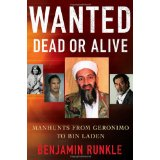Wanted Dead or Alive: An Interview with Benjamin Runkle

Benjamin Runkle’s Wanted Dead or Alive: Manhunts from Geronimo to Bin Laden is the best book on manhunting that I have read combining detailed research into a fast-paced story that reads like a novel of similar genre. The author is a former paratrooper and presidential speechwriter with a Harvard PhD and a veteran of Operation Iraqi Freedom. He has worked in the Department of Defense and the National Security Council. We asked Ben to answer several questions for SWJ in order to describe his book and provide some personal insight.
The impact of Strategic Manhunting has been dismissed in the post-9/11 era as “mowing the lawn” or simply “cutting off the arm of the starfish.” The conventional wisdom in some sectors assumes that modern terrorists’ organizations are sufficiently decentralized networks immune to decapitation. In Wanted Dead or Alive: Manhunts from Geronimo to Bin Laden, you seem to take a contrarian view arguing that the American government has a long tradition of manhunting with mixed results and that this specific mission should continue to play a role in modern warfare. Why did you choose this argument and study, and what did you learn from your research and writing?
In the introduction to Savage Wars of Peace, Max Boot notes the similarity between the post-9/11 pursuit of Osama bin Laden and previous U.S. hunts for insurgent leaders/bandits such as Emilio Aguinaldo, Pancho Villa, and Augusto Sandino. Boot’s chapters on these hunts – which subsume them in the larger strategic problem of “small wars” – intrigued me, not necessarily because of the analytical opportunity, but because they are such great adventure stories, and I wished he’d been able to carry his narrative forward into the 1990s when U.S. forces pursued Manuel Noriega, Mohammad Farah Aideed, and Pablo Escobar. So I think my original intent was just to tell some great Tom Clancyesque stories drawn from U.S. military history, and to demonstrate continuity between long-forgotten campaigns and modern operations.
The analytical “lessons learned” were almost serendipitous. When I began research, I assumed that killing or capturing a targeted individual was strategically decisive. So I was surprised that upon reviewing the eleven campaigns I found little-to-no correlation between operational and strategic success. Most of the times we were strategically successful – whether or not U.S. forces killed or captured the target – were because U.S. forces succeeded in dismantling the target’s support network at the same time they pursued him. Although capturing Geronimo and killing Che Guevara were important, the Apache Wars and Bolivian insurgency were ended through broader counterinsurgency measures. Similarly, capturing Noriega was a necessary step towards achieving our strategic goals in Operation Just Cause, but it would not have been sufficient had the Panamanian Defense Forces remained intact and installed a new strongman to threaten U.S. interests and lives.
Thus, even if we don’t kill or capture the targeted individual, it is possible to be strategically successful if his network is sufficiently attrited: Villa and Sandino are examples of where we failed to apprehend the targeted individual but achieved our broader strategic objectives. Conversely, you can kill/capture a leader, but if you fail to neutralize the subordinates or rivals who may assume his role while he goes to ground (i.e. the Cali Cartel post-Escobar, the Sunni insurgency post-Saddam) you are in some sense back to square one. I think, therefore, that a better metaphor than the “starfish” for strategic manhunts is that of the Hydra in Greek mythology. Besides cutting off the head, to be strategically successful you need to take steps to ensure two more do not grow in its place. But it can be done.







I was fortunate enough to read an advance copy (draft) and could not agree with Mike more. Not only was the book topical and very interesting, it also read like a fast-paced novel. Highly recommended, especially since history has a strange habit of repeating itself. – Dave D.